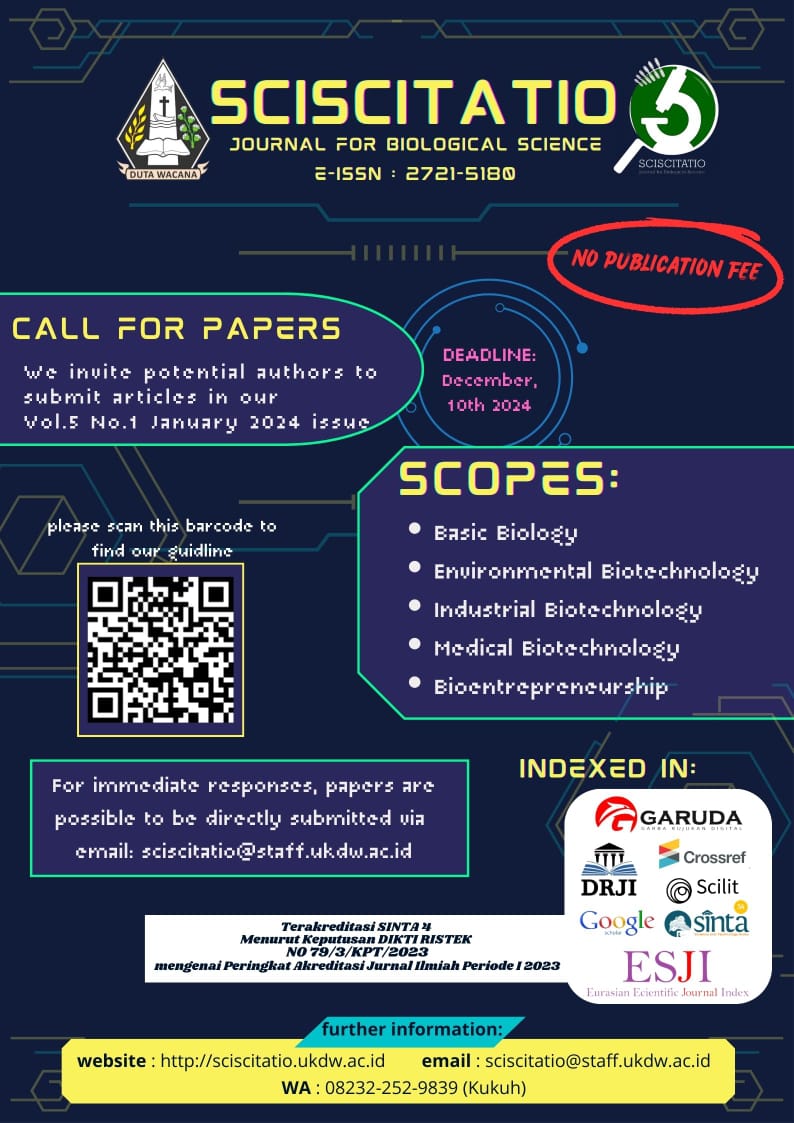Article Template
Author guidelines
Sciscitatio encourages authors to submit articles on these following writing guidelines:
- Submitted articles have not been published in any other journal and does not contain any elements of plagiarism.
- Original research aticle is the only type of article we accept.
- Article is written in Bahasa Indonesia, but preferable in English, using academic language with standard academic writing structure and composition. Article is written using Microsoft Word (.doc or .docx), typed 1,5 spaced using Bookman Old Style font type, size 12 in a quarto paper size (A4), between 8-15 pages in length including references, pictures, and tables.
- Title, abstract, and keywords should be written in both Indonesian and English.
- Article should be in form of essay with the following structure:
- Title (max 12 words): comprehensive, clear, precise and does not contain sub titles. Title is written in capital letter with the font size of 14, formatted in bold and 1 space.
- Author’s names should be written without academic degree with an e-mail address of corresponding author. Name of each author institution and institution address should also be written.
- Articles completion date should be written under author’s address to show it’s progress.
- Abstract is written in Bahasa Indonesia and English, formulated in one paragraph contained 100-150 words representing aim, method and result of the paper.
- Key words in English and Bahasa Indonesia (5-7 words).
- Any citation using in the article should referred to Harvard Referencing Style.
- Introduction contains background of the research, literature study that support the research and the aim of the research.
- Materials and methods contain any material, tools, equipment,software, experimental design applied by authors in their research.
- Result contains any results obtained by the author in their research and. Result could be presented in figure and table, which include title, number, as well as detailed information and should be referred in the text (figure title and number are written under the figure/picture, while table title and number are written above the table).
- Discussion contains a comprehensive discussion to compare their findings with other published research articles findings.
- Conclusion contain the answer for author’s aim of the research.
- Acknowledgement and thanks note can be written precisely if needed.
- References list contain each written material using by authors to support their writing. Reference list format is based on Harvard referencing style and ordered alphabetically (see the detailed below).
- Article should be submitted via online submission on Sciscitatio.
- Notifications for editorial decisions to inform whether the article is accepted or not will be informed to the authors by e-mail. Article that are not published will not be returned to the authors.
- Author must be willing to revise the reviewed article before being published by Sciscitatio.
- Once after published, authors will receive 3 (three) copies of the printed journal contained their article published.
- Sciscitatio encourages authors to employ Mendeley as a reference management software.
Examples of writing Reference List using Harvard Referencing style
Scientific Journal
Amarantini, C & Budiarso, T.Y. (2013) 16S rDNA Typing of Salmonella Typhi Strains from Different Geographical Locations in Sumba Island, East Nusa Tenggara, Indonesia, Microbiology Indonesia, 7 (1), 17-23.
Pakpahan, S., Artama, W. T., Widayanti, R., & Suparta, I. G. (2015). Genetic variations and the origin of native Indonesian goat breeds based on mtDNA D-Loop sequences. Asian Journal of Animal Science, 9, 341-350.
Sudan, K., Vijayan, V., Madyaningrana, K., Gueler, F., Igarashi, K., Foresti, R., Motterlini, R., & Immenschuh, S. (2019) TLR4 activation alters labile heme levels to regulate BACH1 and heme oxygenase-1 expression in macrophages. Free Radical Biology and Medicine, [online] 137(6), 131-142. Available from: doi: 10.1016/j.freeradbiomed.2019.04.024 [Accessed 20th January 2008].
Books
Reece, J. B., Urry, L. A., Cain, M. L., Wasserman, S. A., Minorsky, P. V., and Jackson, R. B. (2014). Campbell Biology (No. s 1309). Boston: Pearson.
Simons, N. E., Menzies, B. & Matthews, M. (2001) A Short Course in Soil and Rock Slope Engineering. [Online] London, Thomas Telford Publishing. Available from: http://www.myilibrary.com?ID=93941 [Accessed 18th June 2008].
Chapter in book
Webb, C.O., Cannon, C.H., & Davies, S.J. (2008) Ecological organization, biogeography, and the phylogenetic structure of rainforest tree communities. In: Carson, W., & Schnitzer, S. (eds) Tropical forest community ecology. Wiley-Blackwell, New York, pp. 79-97
Meinhardt, F., & Klassen, R. (2009) Yeast killer toxins: fundamentals and applications In: Anke, T., & Weber, D (eds) The Mycota. Physiology and Genetics, vol XV. Springer, Berlin, pp 107-130
Proceeding
Rozi, F., Sutrisno, I., Radjit, B.S., Krisdiana, R. (2014) Respon petani terhadap teknologi baru untuk menghasilkan kacang hijau yang berdaya saing. Dalam: Saleh, N., Harsono, A., Nugrahaeni, N. (eds). Prosiding Seminar Nasional Hasil Penelitian Tanaman Aneka Kacang dan Umbi Tahun, 22 Mei 2013, Balitkabi, Malang, hlm.483-491
Wittke, M. (2006) Design, construction, supervision and long-term behaviour of tunnels in swelling rock. In: Van Cotthem, A., Charlier, R., Thimus, J.-F. and Tshibangu, J.-P. (eds.) Eurock 2006: Multiphysics coupling and long term behaviour in rock mechanics: Proceedings of the International Symposium of the International Society for Rock Mechanics, EUROCK 2006, 9-12 May 2006, Liège, Belgium. London, Taylor & Francis. pp. 211-216.
Script, Thesis, and Dissertation
Andini, D. (2014) Deteksi molekuler Salmonella sp pada susu sapi mentah menggunakan penanda parsial sekuen gen 16S rRNA [skripsi]. Universitas Kristen Duta Wacana, Yogyakarta, Indonesia.
Amarantini, C. (2010) Epidemiologi molekuler Salmonella typhi penyebab demam tifoid asal wilayah endemik Kabupaten Sumba Barat Daya Nusa Tenggara Timur [disertasi]. Universitas Gadjah Mada, Yogyakarta, Indonesia.

